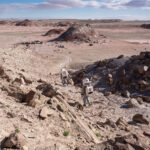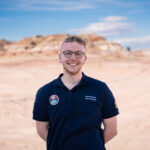During these two weeks, our crew will aim to accomplish their experiments in the best way possible. Every crewmate has chosen an experiment in their domain of expertise and has prepared it thoroughly. Here are the details and mission plans of every experiment.
“Confinement FOMO” – Aglaé Sacré
FOMO, “Fear of missing out”, can appear when we are cut out of society. The Mars simulation completely cuts the crew off of the network and the outer world, which makes it the best place to study how the lack of social media affects the mental condition of not wanting to miss on something. This analysis will be done by anonymous questionnaires before, during (30 min every other day) and after the mission. This way Aglaé could compare how the crew used to use social media, how they predicted they would live without it and how they actually lived without it. Aglaé will be doing this for her Master’s thesis that she will present in June to the jury of UCLouvain.
Collaborator: François Lambotte, Director of School of Communication at UCLouvain.
“Radiation: how attached are we?” – Thomas Stinglhamber
Every day, everywhere, different types of radiation attack us. On Mars, radiation will be way more brutal and dangerous than on Earth due to the difference of the atmosphere. It is thus very important to be able to have easy ways to measure the dosage of this radiation. Thomas will install dosimeters both inside and outside the station to check how radiation proof the station actually is. The crewmates also get an individual dosimeter that they wear at all times to measure their personal dosage. Complementary to this, Thomas will use a Gamma detector to map out the dosage of the soil and try to find radioactive isotopes near the station.
Collaborator: Pascal Froment, CEO of BeSure
“High Speed Rotor Manufacturing” – Gwenael le Bussy
The Martian atmosphere is a hundred times less dense than the one on Earth. This means that every flying object we would like to use for observation, scouting or measurements needs to be adapted to the physics of that new environment. Like the ones on Ingenuity, the rotor blades have to have a special shape. Naturally, every piece of equipment may encounter a problem and need to be repaired or replaced. The problem cannot be predicted precisely in advance, which means that we need an adaptable solution. Gwenael will study how he can use 3D printing to model (with SolidWorks with NACA profile) and print rotor blades for the Martian atmosphere. Afterwards, he will test them with a high speed motor and measure their thrust with a scale.
“Space Oddity” – Ioana Dimitrova
Long term spaceflight separates astronauts from society and their loved ones for months and months. It also keeps them confined without leaving them a possibility to feel free and do whatever they want. This can lead to mental health problems, tensions within the team and can put the mission at risk. Music could be a cheap, easily transportable and effective solution to this problem. Choosing your personal music to help you relax could have multiple benefits. It could help you transport yourself elsewhere, work through your emotions and stimulate your senses. Ioana will test if this theory is true by measuring cardiac parameters during relaxing times with and without music chosen by the crew. The technology used for the measurements is KINO by HeartKinetics. It is an app that you put on your chest and that analyses your heart.
Collaborator: HeartKinetics
“Hide and seek during radiation storms” – Augustin Tribolet
As we mentioned earlier, radiation is an important factor in a Mars mission. If we are to live there or try to make bacteria or plants survive, we must find the most protected areas on the surface. An easy way to be able to find those places could be to use a drone to map out the area and to find these places. Augustin will use a drone to scan the surface and generate a 3D model by photogrammetry. This digital technique allows us to build the 3D model from photographic images. He will work closely with Agnes who studies extremophiles (see below) to analyse how effective his hiding places actually are.
Collaborator: Jerome Loic, Bernard Foing, Jeff Rayner, CEO of MXTreality
“Mars well-being” – Ttele Hiriart
Confinement, isolation, extreme conditions… All these factors affect mental health and team dynamics. How do girls react differently to boys? How does the team work together? How do the dynamics evolve? Which teamwork tools actually work? During the mission, Ttele will keep a diary of her observations of the team and different crewmates. She will compare these observations with the ones made by other mission simulations in Antarctica for example. She will also introduce some teamwork exercises to see if they help. At the end of the mission, she will present her observations of the ups and downs of the mission, how the team interacted and different lessons the team has learned or must work on for future missions.
“I will survive” – Agnes Dekeyser
I will survive !
As you may know, the planet Mars is currently not habitable for life as we know it due to its extreme
conditions. We are talking about an atmospheric pressure that is 1% of that found on Earth (at sea
level), an average temperature of -60°C, and an atmosphere composed of only 0.1% oxygen.
However, there are microorganisms on Earth that could withstand such conditions. They are called
"extremophiles". These are microorganisms that live in conditions that are lethal to most other
microorganisms. They live on the seabed, in the earth’s crust, in glaciers, and in many other extreme
environments. During this simulated mission on the planet Mars, our Crew Executive Officer will
study the viability of two strains of extremophiles after exposition to MDRS environmental conditions
: Deinococcus Radiodurans and Cupriavidus Metallidurans. Each strain will be exposed outside for 8
days in anaerobic condition. Their viability will be compared to their unexposed analogues based on
CFUs (Colony-Forming-Units) analysis.
“We are what we eat” – Antoine de Barquin
The goal of his experiment is to understand the impact of specific nutrition and confinement on the intestinal flora of astronauts. To conduct this study, a sample of each crew member was taken before departure to perform an analysis of intestinal bacteria by targeted metagenomics. This analysis is performed at the LIMS MBnext laboratory which collaborates with our crew for this experiment. Antoine will monitor everything the crew eats, type of food, quantities, time of the day etc. He will start analysing the data during the mission and will conclude the analysis after the return on Earth. The crew will give “post-mission” samples. This way, Antoine will be able to compare and analyse how the team is affected by everyone’s microbiote.
Collaborator: LIMS MBnext Laboratory



















You must be logged in to post a comment.